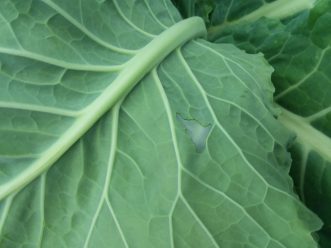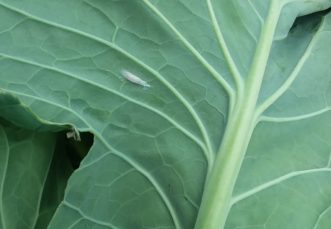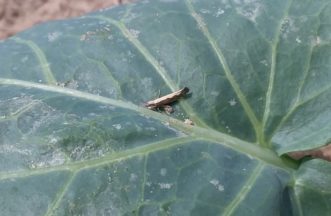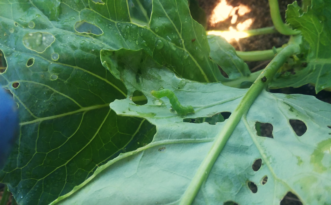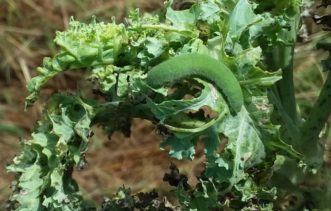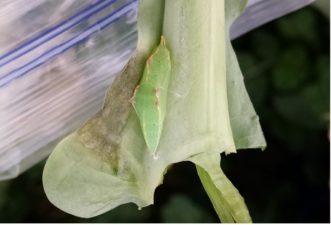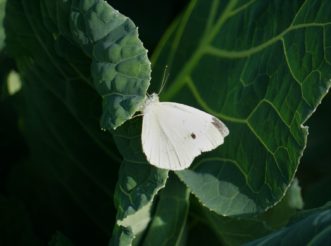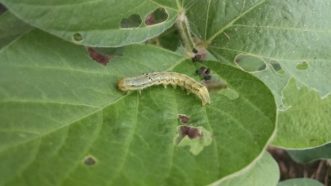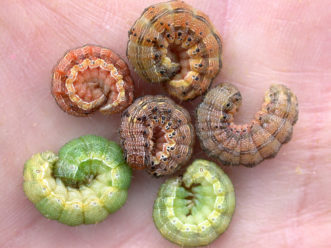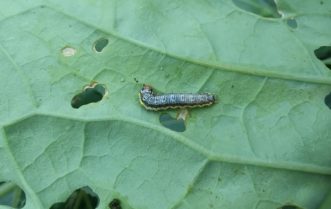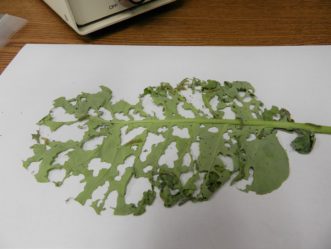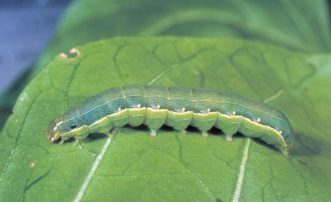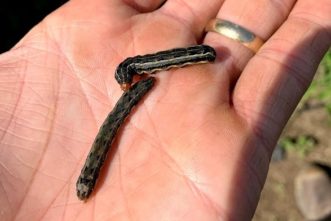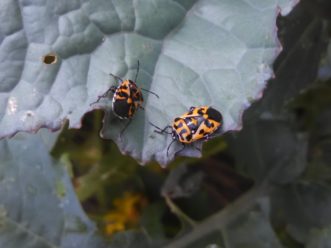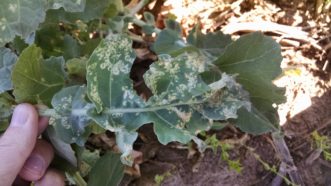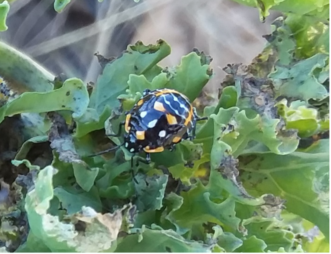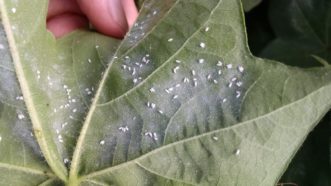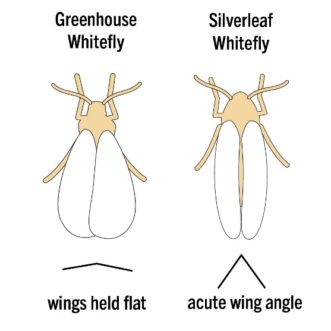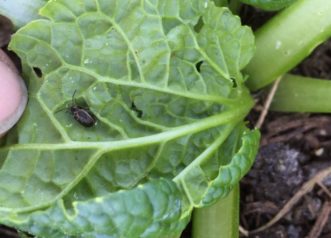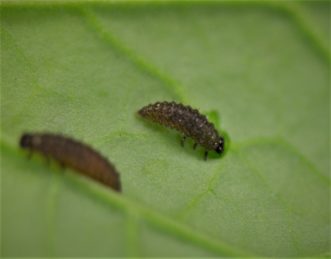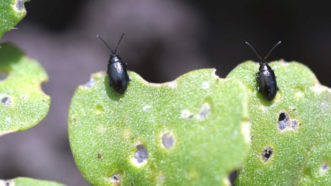Brassica crops are susceptible to feeding damage from many chewing and sucking insect pests. This article describes identification features and biological information needed to help growers correctly identify common insect pests of brassicas.
Introduction
Crops in the family Brassicaceae (known as brassicas) include collards, kale, mustard, cabbage, broccoli, turnips, and many others. Over 9,500 acres of brassica crops were grown by South Carolina producers in 2016, accounting for over $48 million in sales.1 Insect feeding damage is one of the most significant causes of yield and quality loss in brassica crops. Each year, South Carolina producers spend an average of $600 per acre managing insect pests.2
Correctly identifying pests is the first step in a responsible management program. The photos and descriptions below can be used to help identify pests prior to making treatment decisions. Extension agents can provide identification assistance when needed.
Caterpillar Pests of Brassica Crops
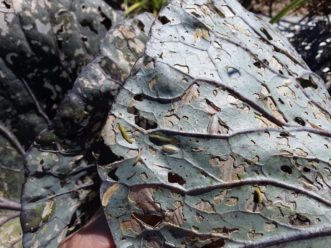
Figure 1. A complete control failure of caterpillar pests can result in significant crop defoliation. Image credit: Justin Ballew, Clemson Cooperative Extension.
Caterpillars are the immature form of butterflies and moths and are the most common and severe insect pest of brassica crops. Caterpillars have chewing mouthparts and create holes in foliage (figure 1), bore into the heads of cabbage, and feed on the florets of broccoli and cauliflower. In addition, frass excreted as caterpillars feed may contaminate and stain harvested greens, reducing marketability. The diamondback moth caterpillar (Plutella xylostella) (DBM), cabbage looper (Trichoplusia ni), and imported cabbageworm (Pieris rapae) (ICW) are the predominant caterpillar pests of brassicas. Together they are known as the “cabbageworm complex.”
Diamondback Moth Caterpillar
The DBM caterpillar (Plutella xylostella) is the most common and problematic caterpillar pest of brassica crops, though it is the smallest.3 They have a short life cycle (average of 32 days), and females lay an average of 150 eggs during their two-week lifespan. This allows populations to build quickly, which is the main reason DBM are so destructive. Rapid population growth also allows DBM populations to readily develop insecticide resistance, presenting a significant challenge to control efforts.

Figure 2. Diamondback moth caterpillars are the most serious pest of brassica crops. Image credit: Justin Ballew, Clemson Cooperative Extension.
Diamondback moth larvae are small caterpillars, reaching just 0.5 inches in length prior to pupation (figure 2). They have four pairs of abdominal prolegs, though a hand lens may be needed to view them. When disturbed, they may either drop from a silk thread to evade danger or thrash about violently. Holes in the leaves caused by feeding often do not go all the way through the leaf. Instead, the upper leaf surface may be left intact (figure 3). This “windowpane” feeding damage is often created by early instar (or growth stage) larvae. Diamondback moths pupate in loosely woven cocoons, usually on the undersides of leaves (figure 4). The adult is a small, brownish-colored moth (figure 5) with a diamond-shaped pattern visible on the top of its wings, hence its common name. When at rest, its wings are folded down the length of its body, giving it a slender profile. The adult moths are weak fliers and disperse only a few hundred feet from where they pupate, though they may be carried longer distances by the wind.4
Cabbage Looper
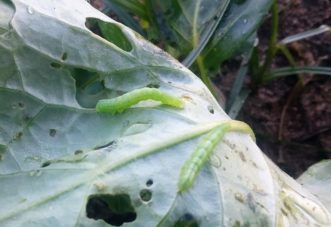
Figure 6. Cabbage loopers have two pairs of abdominal prolegs and are fatter on the tail end than the head. Image credit: Justin Ballew, Clemson Cooperative Extension.
Cabbage loopers (Trichoplusia ni) are one of the largest brassica caterpillar pests (figure 6). One cabbage looper creates about the same amount of feeding damage as five DBM.5 Cabbage loopers are more problematic some years than others. Cabbage looper larvae are fatter on the tail end than the head and reach a length of 1.25 to 1.50 inches before pupating. They have two pairs of abdominal prolegs, which is unique among brassica caterpillars (figure 7). All others have four pairs. Loopers crawl with a characteristic “looping” motion. When disturbed, they often rear up like a cobra to intimidate predators (figure 8). Cabbage looper feeding causes holes in the leaves that are usually much larger than those of the DBM. Cabbage loopers pupate in a loosely woven cocoon on the underside of leaves. The adult is a rather nondescript, brown-colored moth with white shapes on its forewings resembling a U and a circle. Cabbage looper moths are mostly nocturnal and are excellent fliers, able to disperse miles from where they pupate.4
Imported Cabbageworm
Imported cabbageworms (Pieris rapae) differ from DBM and cabbage loopers in that the adult is a butterfly rather than a moth. One ICW creates approximately the same amount of feeding damage as three DBM.5 Imported cabbageworm larvae reach a length of around 1 inch before pupating. They have four pairs of abdominal prolegs and are covered in a fine pubescence that gives them a fuzzy appearance (figure 9). The ICW pupates in a chrysalis (figure 10) attached to the host plant by its lower end (abdomen) and has a thin strand of silk wrapped across the thorax to help maintain its position. The adult is a white butterfly with grey markings, known as the cabbage white or the cabbage butterfly (figure 11). They are diurnal (active during the day) and commonly forage flowering weeds on field edges.
Corn Earworm
Corn earworms (Helicoverpa zea) are an occasional pest of brassica crops. They are medium to large-sized caterpillars with four pairs of abdominal prolegs (figure 12). Their body is covered in hair-like microspines that distinguish it from similar-looking armyworms, which lack this feature.4 Corn earworms vary in color from green to yellow, brown, pinkish, or almost black (figure 13). When disturbed, larvae may curl into a spiral, sometimes causing them to fall from the host plant. Mature larvae drop to the ground to pupate in the soil; therefore, pupae are rarely observed. The adult is a nondescript greyish-brown moth and is primarily nocturnal.
Cross-Striped Cabbageworm
The cross-striped cabbageworm (Evergestis rimosalis) is a medium-sized caterpillar with four pairs of abdominal prolegs. They have distinct black and white stripes across their back and a yellow stripe that travels down either side of their body (figure 14). Adult moths lay eggs in masses with 3 to 25 eggs in each mass.6 When the eggs hatch, the host plant can be quickly skeletonized (figure 15). Caterpillars show a preference for feeding on tender leaves, especially at the growing point, but may also bore into developing cabbage heads. They grow to about 0.75 inches before dropping to the soil to pupate just below the surface.
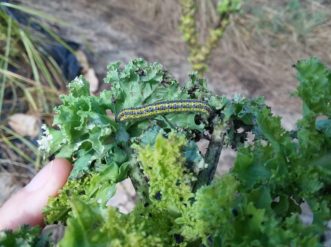
Figure 16. Southern cabbageworms are similar to imported cabbage worms but can be distinguished by their alternating grey and yellow longitudinal stripes. Image credit: Justin Ballew, Clemson Cooperative Extension.
Southern Cabbageworm
The southern cabbageworm (SCW) (Pontia protodice) is similar in appearance to the ICW. They have four pairs of abdominal prolegs and are covered in a fine pubescence. The color of the SCW distinguishes it from the ICW. The SCW has alternating grey and yellow longitudinal stripes traveling the length of their body (figure 16). Like the ICW, SCW larvae reach a length of around one inch before pupating in a chrysalis. The adult is a small, white butterfly with grey markings known as the checkered white. It is diurnal and can be spotted foraging wildflowers on field edges. The preferred host plant of SCW is Virginia pepperweed (Lepidium virginicum), though it will feed on numerous cultivated brassica species.7
Armyworms
Beet armyworms (BAW) (Spodoptera exigua) are perhaps the most common armyworm pest of brassica crops (figure 17), though the Southern armyworm (SAW) (Spodoptera eridania) is occasionally found as well (figure 18). Both look similar, though the SAW can be distinguished by a large, dark-colored spot located on its sides, just behind the last pair of true legs.4 Both armyworms have four pairs of abdominal prolegs and are variable in color, ranging from yellow to green to black, though the SAW is usually darker than the BAW and has a brown to reddish-colored head. Both also have a light or white-colored stripe that travels the length of either side of their bodies. Both lack hairs and spines, distinguishing them from corn earworms.4 Adults of both species are nondescript brown-colored, nocturnal moths.
Cabbage Webworm
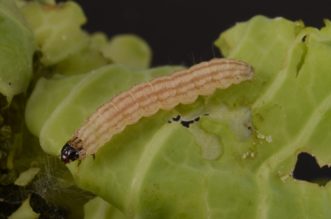
Figure 19. Cabbage webworms may cause severe damage to buds and growing points of developing plants. Image credit: Lyle Buss, University of Florida.
Cabbage webworms (CWW) (Hellula rogatalis) create webs in the tender foliage of the host plant to protect themselves from natural enemies. They feed on the leaves and midribs of brassicas and may cause severe damage to the buds and growing points of developing plants, resulting in lateral budding.8 Larvae are small (reaching less than 0.5 inches before pupating) and tan colored with brown longitudinal stripes that travel their bodies’ length (figure 19). Eggs are usually laid on terminal leaves singly or in masses.9 Early instar larvae feed between the upper and lower epidermis of the leaf, while later instar larvae feed on the lower leaf surface. Pupation occurs in the soil. The CWW is an occasional pest in South Carolina.
Other Insect Pests
Harlequin Bug
Harlequin bugs (Murgantia histrionica) are stink bugs with a unique reddish-orange and black pattern on their back (figure 20). Stink bugs feed by inserting their needle-like mouthparts into the host’s leaves and sucking out the sap. Harlequin bug feeding creates distinct damage on the foliage of brassica crops that resembles a tie-dye pattern (figure 21). Females lay clusters of black and white-striped eggs that resemble tiny barrels or kegs (figure 22). Nymphs (juveniles) are similar to adults in shape and color but lack fully developed wings (figure 23). The pattern on their back becomes more elaborate as they develop.
Aphids
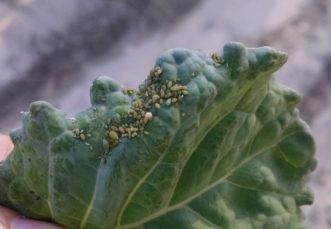
Figure 24. An aphid colony infesting a collard leaf. The tan, round-looking aphid has been parasitized by a wasp. Image credit: Justin Ballew, Clemson Cooperative Extension.
Cabbage aphids (Brevicoryne brassicae) and turnip aphids (Lipaphis erysimi) are small, greyish-green, soft-bodied insects (figure 24) with piercing-sucking mouthparts. Like harlequin bugs, aphids suck sap from host plants. Feeding damage from large populations often results in wrinkling or curling of the leaves. Yellowing and reduced growth may also occur.10 Honeydew (the excreted waste) and aphids themselves may contaminate harvested leaves or heads. Initial infestations often occur by wind dispersal of winged females. Aphid populations may appear sporadically year-round, though, in South Carolina, they tend to be more damaging to fall crops.
Silverleaf Whitefly
Whiteflies are small, yellowish-bodied insects with white-colored wings (figure 25). They are found primarily on the leaves’ underside, where they feed on the plant’s sap with their piercing-sucking mouthparts. Multiple species may infest brassica crops, though the silverleaf whitefly (SLWF) (Bemisia argentifolii), also called the sweetpotato whitefly, is the most problematic. It can be distinguished from the similar-looking greenhouse whitefly (GHWF) by examining its wings under a hand lens.11 The SLWF holds its wings tilted over its abdomen like a gabled roof (figure 26). Additionally, there is a small gap between the wings. The GHWF holds its wings flatter and lacks the gap between its wings. Feeding by large SLWF populations may reduce growth and cause a silver discoloration to the leaves. It is also a vector of plant viruses.
Yellowmargined Leaf Beetle
The yellowmargined leaf beetle (Microtheca ochroloma) is a small beetle pest of brassica crops that creates holes in the leaves and roots as they feed with their chewing mouthparts. Turnip and mustard are their preferred hosts and may be seriously damaged.12 Adults are small (just under 0.25 inches), dark-colored beetles with a lighter colored band around the margin of their elytra (wing covers) (figure 27). Larvae are similarly sized, dark-colored, and have setae (fine hairs) covering their soft bodies (figure 28). Adults and larvae cause feeding damage.
Flea Beetles
Flea beetles are small beetles with powerful hind legs that allow them to leap away when disturbed. Several species feed on brassica crops, including the crucifer flea beetle (Phyllotreta cruciferae) (figure 29) and the striped flea beetle (Phyllotreta striolata).13 On brassicas with waxy leaves, such as collards, broccoli, cabbage, and kale, flea beetles are most damaging when the plants are small and tender (figure 30). As the plants grow, it becomes more difficult for them to feed on the waxy leaves with their tiny, chewing mouthparts.14 For brassicas that lack the waxy leaf coating, such as mustard and turnip, flea beetles can be problematic during all growth stages.
Management of Brassica Insect Pests
Integrated pest management incorporates cultural, biological, mechanical, and chemical management strategies for managing pests. The Southeastern US Vegetable Crop Handbook is an excellent source of information for cultural, mechanical, and chemical management.
References Cited
- Farm Gate Value Survey and Reporting System. Athens (GA): University of Georgia; 2016. https://farmgate.caes.uga.edu/Reporting_DetailedReports.aspx.
- Nelson, B. Melons and veggies enterprise budgets. Clemson (SC): Clemson University, Agribusiness Program Team; 2020. https://www.clemson.edu/extension/agribusiness/enterprise-budget/melons-vegetables.html.
- Philips CR, Fu Z, Kuhar TP, Shelton AM, Cordero RJ. Natural history, ecology, and management of diamondback moth (lepidoptera: plutellidae), with emphasis on the United States. Journal of Integrated Pest Management, 2014; 3: D1–D11. doi:10.1603/IPM14012.
- Capinera JL. Handbook of vegetable pests. 2nd ed. San Diego (CA): Academic Press; 2020.
- Maltais PM, Nuckle JR, LeBlanc PV. Economic threshold for three lepidopterous larval pest of fresh-market cabbage in southeastern New Brunswick. J. Econ. Entomology. 1998;91:699-707.
- Sparks Jr A, Riley DG. Cross-striped cabbageworm. Athens (GA): University of Georgia Extension. https://extension.uga.edu/content/dam/extension/programs-and-services/integrated-pest-management/documents/insect-pdfs/crosstripedcab.pdf.
- Hall D. Southern cabbageworm (larva), checkered white (adult) Pontia (=Pieris) protodice (Boisduval & Leconte) (Insecta: Lepidoptera: Pieridae: Pierinae). IFAS Extension. Gainesville (FL): University of Florida; 2009 Feb. https://edis.ifas.ufl.edu/pdffiles/IN/IN79300.pdf.
- Bessin R. Cabbage webworm. Lexington (KY): University of Kentucky College of Agriculture, Food and Environment; 2019 Nov. https://entomology.ca.uky.edu/files/efpdf2/ef315.pdf.
- Shrestha D, Webb SE. Cabbage webworm – Hellula rogatalis. Featured creatures: entomology & nematology. Gainesville (FL): University of Florida; 2016 Mar. http://entnemdept.ufl.edu/creatures/VEG/LEAF/cabbage_webworm.htm.
- Higgins G. Aphid, cabbage. Amherst (MA): University of Massachusetts Amherst, . https://ag.umass.edu/vegetable/fact-sheets/aphid-cabbage.
- UC IPM, Statewide Integrated Pest Management Program. Davis (CA): University of California Agriculture & Natural Resources; 2009 Sep. http://ipm.ucanr.edu/PMG/r108301411.html.
- Fasulo TR. Yellowmargined leaf beetle, Microtheca ochroloma. Featured creatures: entomology & nematology. Gainesville (FL): University of Florida; 2019 Oct. http://entnemdept.ufl.edu/creatures/veg/leaf/yellowmargined_leaf_beetle.htm.
- Mason JA, Kuhar TP. Evaluation of insecticides for the control of flea beetles in cabbage. Blacksburg (VA): Virginia Cooperative Extension; 2018. Arthropod Management Tests, 41(1), tsw013.
- Grubinger V. flea beetles management. Burlington (VT): University of Vermont; 2003 Nov. https://www.uvm.edu/vtvegandberry/factsheets/fleabeetle.html.

